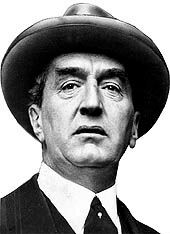This is a paragraph from Colebatch's article:
"This budget is Labor's last chance to get it right. Its complacency about the real state of the economy is breathtaking; 60 of its 72 MPs are in the south-eastern states, which are being flattened to allow the mining boom to go full speed without triggering high inflation". (See here)
October 12, 1929.
 |
| Stanley Bruce. [A] |
The 36-seat Senate remained in control of the Coalition Nationalist Party/Country Party (29 seats).
The preceding Prime Minister, Stanley Melbourne Bruce, 1st Viscount Bruce of Melbourne (Nationalist/Coalition) lost his own seat of Flinders to Labor's Jack Holloway. [2]
The Coalition had to call elections after the controversial Maritime Industries Bill, designed to transfer industrial relations arbitration powers from the Commonwealth Court of Conciliation and Arbitration to the Commonwealth was defeated in Parliament.
October 22, 1929.
 |
| James Scullin. [B] |
October 24, 1929: Black Thursday.
The Dow Jones Industrial Average lost 11%: the Great Depression began.
1930.
At one hand James Fenton and Joseph Lyons supported deflationary economic policies, with the advice of Sir Otto Ernst Niemeyer (director of the Bank of England).
At the other hand, NSW Premier Jack Lang, Ted Theodore, the caucus and the unions strongly opposed these policies and called for policies currently associated with Keynes.
Scullin (who accumulated the Treasury portfolio) left Australia for five months, to negotiate new low-interest loans, to assist to the Imperial Conference and to push to have Sir Isaac Isaacs appointed the first Australian-born Governor General.
Fenton (acting PM) and Lyons (acting Treasurer) were left in charge, applying budget cuts, with the approval of most state premiers.
1931.
Scullin returned to Australia and reinstated Theodore as Treasurer. Fenton and Lyons resigned and joined the Nationalists, in the rechristened United Australia Party.
Labor lost the December 19, 1931 federal elections [3]. Its House representation fell to 14 (from 46 in October 1929), its Senate representation fell to 3 (from 7 since November 1928).
Aftermath
Joseph Lyons was elected PM (06-01-1932 to 07-09-1939) and applied the policies Niemeyer recommended. Unemployment in Australia peaked at 29% in 1932. Australian recovery was slower than in the US, UK and New Zealand.
It took Labor nearly ten years to return to power.
----------
You can hear and read here what the likely next Treasurer said last night, and here what the current Treasurer has said.
----------
Update:
23-04-2012. Peter Hartcher's scenarios:
"LABOR would suffer its worst result in the Senate since 1944 if an election were held now, giving Tony Abbott control of the upper house as well as the lower, an analysis shows.
"This would allow him to wipe out many of the big achievements of the five years of Labor governments, as he has pledged to do, though some financial and legal complications would remain." (See here)
Notes:
[1] All election results data from Australian Politics and Elections Database. The University of Western Australia.
[2] Bruce kept the dubious honor of being the only Australian Prime Minister to lose his seat, until John Howard joined him in that exclusive club, in 2007. The 2007 federal election was dominated by the industrial relations issues originated by Howard's Work Choices industrial relations legislation.
[3] To date, the Scullin ministry is the only Australian government not to be re-elected at least once.
Image Credits:
[A] Stanley Bruce. Wikipedia.
[B] James Scullin. Wikipedia.
No comments:
Post a Comment